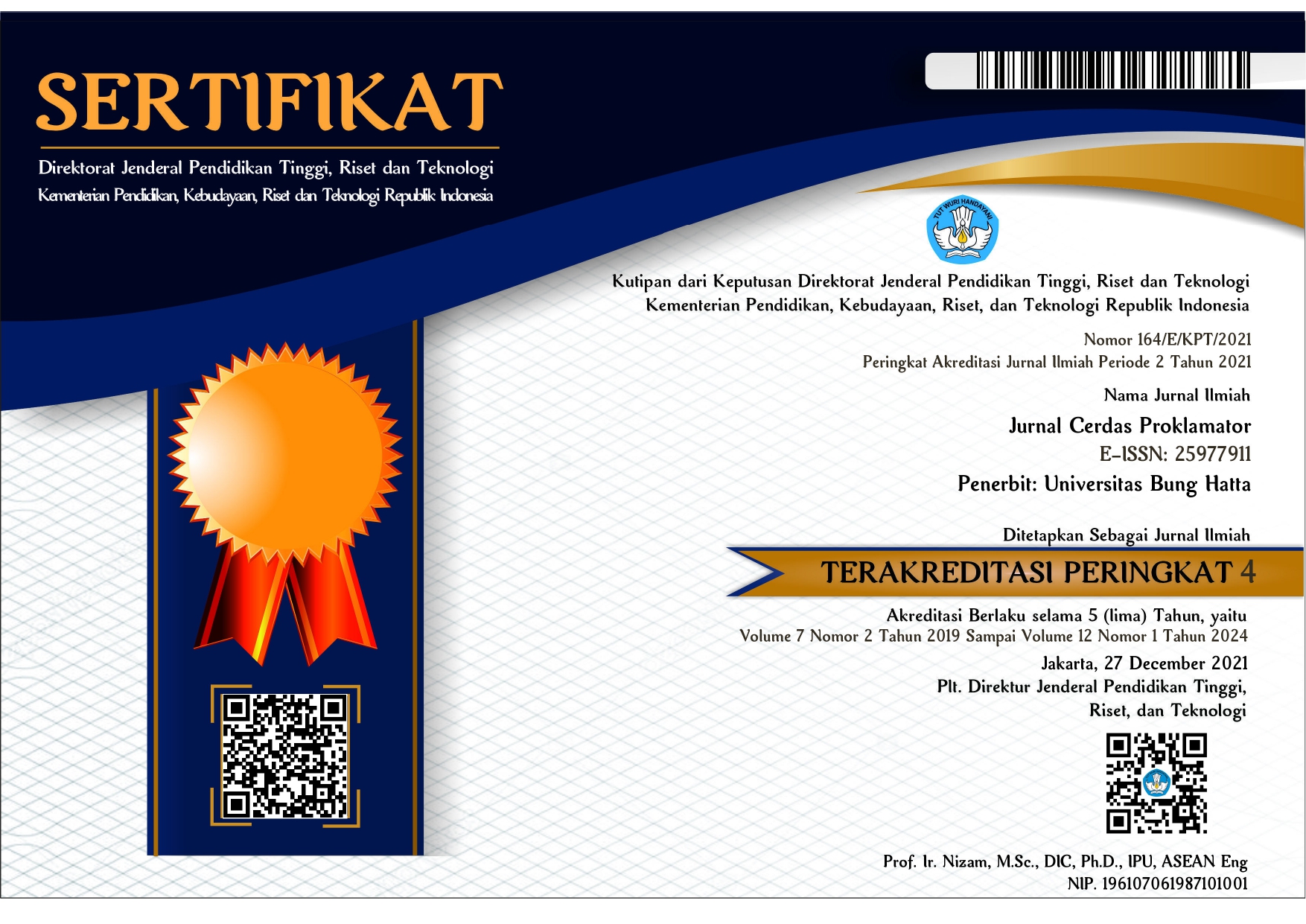PENGARUH STRATEGI PEMBELAJARAN AKTIF TIPE THE GREAT WIND BLOWS TERHADAP TINGKAT KECEMASAN MATEMATIS SISWA DI SEKOLAH DASAR
Keywords:
Active Learning, Mathematical Anxienty, The Great Wind BlowsAbstract
Math anxiety is one of the most serious obstacles in education. Based on the results of observations, there are early indications that students experience anxiety in learning mathematics. The purpose of this study was to see the effect of the great wind blows type of active learning strategy on the level of students' mathematical anxiety. The method used for this paper is a quantitative method using a pre-experimental design. the pre-experimental design with the one group pretest post test design was used because the researcher wanted to see the difference between the level of anxiety before the action was taken and after the action was carried out so that from these results it could be seen whether there was an influence or not from the learning strategy used. The results of this study indicate that the average value of the posttest results obtained an average value of 45.32 with a standard deviation of 8.55 while the pretest results obtained an average value of 54.64 with a standard deviation of 9.21. the great wind blows type of active learning strategy (posttest) tends to decrease compared to before using the great wind blows type of active learning strategy (pretest).
References
Aulia, W., & Miboy, A. (2021). Our Three Solutions in Learning During Pandemic At Sdn 01 Benteng Pasar Bukittinggi City Tiga Solusi Dalam Pembelajaran Pada Masa Pandemi Di. Jurnal CERDAS Proklamator, 9(1), 28–37.
Auliya, R. N. (2016). Kecemasan matematika dan pemahaman matematis. Formatif: Jurnal Ilmiah Pendidikan MIPA, 6(1).
Darmadi, H. (2015). MENJADI GURU PROFESIONAL diperbincangkan , karena guru merupakan sumber kunci keberhasilan pendidikan . didik yang menyangkut berbagai aspek yang bersifat manusiawi yang unik dalam. Jurnal Edukasi, 13(2), 161–174.
Ety Nur Inah. (2015). PERAN KOMUNIKASI DALAM INTERAKSI GURU DAN SISWA Ety Nur Inah. Al-Ta’dib, 8(2), 150–167.
Firdaus, R. (2016). Pengaruh penataan ruang kelas terhadap hasil belajar siswa kelas v (study eksperimen di sdn 4 kuripan utara) tahun 2016.
Hatta, U. B. (n.d.). Create an Effective School Environment. 7(2), 168–178.
Jumrawarsi, & Suhaili, N. (2020). 50 Lembaga Penelitian dan Penerbitan Hasil Penelitian Ensiklopedia PISSN 2657-0297. Ensiklopedia Education Review, 2(3), 50–54.
Pahlawan, U., Tambusai, T., Perwitasari, D., & Fatayan, A. (2022). Jurnal Pendidikan dan Konseling di Sekolah Dasar Islam. 4, 2556–2560.
Sari, S. G., & Mudjiran, M. (2020). Pentingnya Pemahaman Perbedaan Individual (Individual Differences) Bagi Calon Guru Sekolah Dasar. Jurnal Cerdas Proklamator, 8(2), 54–63. https://doi.org/10.37301/jcp.v8i2.59
Septiana, V. W., Pratiwi, S. H., Rozalina, F., Islam, F. A., Muhammadiyah, U., & Barat, S. (2021). Correlation of Interest With Students ’ Learning Outcomes Inipa Learning in Elementary School. Jurnal CERDAS Proklamator, 9(2), 45–52.
Setiawan, H., Fauzan, A., & Arnawa, I. M. (2021). The Development of Geometrical Learning Devices Based on Rumah Gadang Ethnomathematics for Grade VII Junior High School. Journal of Physics: Conference Series, 1742(1). https://doi.org/10.1088/1742-6596/1742/1/012003
Setiawan, Herdi, & Fauzan, A. (2022). Validitas Perangkat Pembelajaran Geometri Berbasis Etnomatematika Rumah Gadang. 06(03), 3486–3494.
Setiawan, Herdi, Fauzan, A., Ananda, A., Pascasarjana, S., Padang, U. N., Artikel, I., Pengembangan, P., Setiawan, H., Pascasarjana, S., Padang, U. N., & Education, J. (2023). Analisis pendahuluan pengembangan perangkat pembelajaran geometri berbasis etnomatematika rumah gadang di smp kelas vii. 11(2), 75–79. https://doi.org/10.37081/ed.v11i2.4574
Setiawan, Herdi, Jamaris, J., Solfema, S., & Fauzan, A. (2022). Validitas Perangkat Pembelajaran Geometri Berbasis Etnomatematika Rumah Gadang. Jurnal Cendekia?: Jurnal Pendidikan Matematika, 6(3), 3484–3494. https://doi.org/10.31004/cendekia.v6i3.1881
Setiawan, Herdi, Pascasarjana, S., Padang, U. N., Pendidikan, F. I., & Padang, U. N. (2022). CREATING A CONDUUSIVE LEARNING ENVIRONMENT FOR ELEMENTARY SCHOOL LEVEL STUDENTS. 10(2), 59–65.
Sugiyanto. (2015). Pengaruh Fasilitas Belajar, Lingkungan Keluarga, dan Lingkungan Sosial Terhadap Hasil Belajar IPS. Seminar Nasional Universitas PGRI Yogyakarta, 3(1), 72–82.
Sugiyono. (2017). Metode Penelitian Pendidikan Pendekatan Kauntitatif, Kualitatif, R&D. In Metode Penelitian Pendidikan Pendekatan Kuantitatif, Kualitatif Dan R&D. Alfabeta.
Tamara, R. M. (2016). Peranan Lingkungan Sosial Terhadap Pembentukan Sikap Peduli Lingkungan Peserta Didik Di Sma Negeri Kabupaten Cianjur. Jurnal Geografi Gea, 16(1), 44. https://doi.org/10.17509/gea.v16i1.3467
Wahid, A. H., Muali, C., & Mutmainnah, M. (2018). Manajemen Kelas Dalam Menciptakan Suasana Belajar Yang Kondusif; Upaya Peningkatan Prestasi Belajar Siswa. Al-Fikrah: Jurnal Manajemen Pendidikan, 5(2), 179. https://doi.org/10.31958/jaf.v5i2.1106
Downloads
Published
Issue
Section
License
Copyright (c) 2024 Jurnal Cerdas Proklamator

This work is licensed under a Creative Commons Attribution 4.0 International License.
Copy right in each article belong to the authors.
1. The author acknowledges that the Journal Cerdas Proklamator as a publisher who publishes for the first time with the
Creative Commons Attribution 4.0 International License.
2. The Author can enter the writing separately, manage the non exclusive distribution of manuscripts that have been published in this journal into the other versions (eg sent to the repository of the author's institution, publication in book, etc), by acknowledge that the manuscript was first published in the Jurnal Cerdas Proklamator.

























